|
by
Gerald Warner, Softball Pitching Instructor

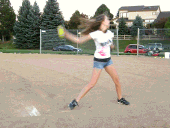
We have
often seen that pitchers, even those who have extensive experience,
have often learned a “wrong” way of doing some part of the pitching
motion or delivery, and consequently might have developed habits
that can limit their ability and success…or even cause
injuries. In many areas
of pitching there is no “right” or “wrong” way of doing something,
but instead a method needs to be chosen that best fits a pitcher’s
personal ability and comfort-level.
However,
with the fundamental “mechanics” of pitching, most qualified
pitching instructors will agree that most of what we have listed
below are the recommended procedures.
________________________________________________________________________________
IMPORTANT: There are a lot of
steps to learn here.
Don’t try to do them all of them at once. Take things one at a
time. Nobody learns the
basic mechanics overnight…take plenty of time to learn and practice
each step. For most pitchers, developing a correct pitching
form...doing all of the mechanics correctly...can take many months,
or even years.
________________________________________________________________________________
(1) MECHANICS FIRST
– Learn, practice,
and develop good pitching mechanics first...do NOT worry about
throwing strikes when you are learning how to pitch. Learn how to do it right,
make certain that everything is correct and smooth, then
later you can start adding speed. Control
(throwing
strikes) should not be an
issue in the beginning.
First learn the correct way of doing the pitching motion and
delivery. Then LATER you
can work on being accurate and throwing
strikes.
(2) BEFORE PITCHING
– Always do
a pre-practice pre-pitching routine. Pitchers who don’t take
adequate time to properly get ready to throw the ball run the risk
of injuring themselves, and always pitch slower and with less
accuracy. A good
preparation always involves (1) Jogging (to loosen tight
body muscles), (2) Stretching (arms, legs,
hamstrings, throwing arm shoulder, and midsection…stomach/abs and
lower back) for several minutes, (3) Loosen the throwing arm by
starting with easy Overhand
throws from a shorter
distance (4) gradually working back to a
Longer
Distance and harder
overhand throwing.
Then, do the same thing underhanded: (5)
Short
distance underhand pitching, then gradually
working back to (6) Full-distance, Full-speed
pitching.
(3) PRESENTATION
– Although this
doesn’t have anything to do with “mechanics” of pitching, this is a
good time to discuss how to properly approach the pitching
rubber. Most
softball leagues and sanctioning associations require girl pitchers
to approach the pitching rubber from behind
(the
side away from the batter) to prepare for a
pitch. So now is
the time to get used to doing it. Step up to the rubber
from behind, and with your hands apart, at your side…a good
idea is to have the ball in one hand, the glove on the other. This is called the
“presentation”… showing the batter that you have the ball and are
getting ready to pitch.
(4) STANCE
– Take a stance on
the pitching rubber that is comfortable…standing tall, with your
shoulders back, and your feet far enough apart for you to be
balanced, hands at your side (ball
in one, glove on the other), and your neck
and upper body muscles feeling totally relaxed. The feet must be
placed where the league and softball sanctioning associations
require them to be.
Typically that means that the front
(throwing
arm side) “push-off” foot
must be placed at the front of the pitching rubber, and at least
half of it must be on the surface of the rubber. The
rear
(or “stride”) glove-side foot
can be behind the rubber.
But with some leagues, the ASA, the NCAA and others, the toe
of the rear foot must at least touching the rear edge of the
pitching rubber.
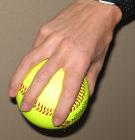
(5)
GRIP– Although there is
no definite right or wrong way for a beginning pitcher to hold the
ball, she should develop habits now in preparation for pitches that
she will be developing later.
Therefore, we recommend that every pitcher start by using a
“4-seam” grip…one that will cause the pitched ball to rotate
top-to-bottom with all four seams cutting the air. For the basic 4-seam grip,
place the pads of your fingers on the seams on the side of
the “U” (horseshoe).
(6) VISUALIZE
– As you are
standing on the pitching rubber getting ready to start your motion,
take a second to try to “see” in your mind the path that the ball
will take when you throw it. Although this is not
really part of basic “mechanics” it is a good idea to get used to
the idea of visualizing the trajectory of the ball… from the
point that you will be releasing it alongside your hip…all the way
into the catcher’s mitt.
The concept of “creative visualization” can eventually also
assist in your fielding, throwing, and
hitting.
(7) BRING THE BALL AND GLOVE
TOGETHER – This is the
part that follows the “Presentation” of the ball that we mentioned
previously. Up to this
point, your pre-pitch stance has kept your hands at your side. Most softball leagues
and associations require that the ball and the glove must touch
together (usually
at least for one second) before starting the pitching
motion. We recommend
that you make the ball-glove contact close to where your hands have
been hanging…in front of you, and below your waist.
(8) STARTING THE MOTION
- Although many
pitchers have developed a habit of a lot of extra motion into the
pre-pitch routine, bring your hands way above your head or bending
over at this point are simply extra movement and energy that is
being used, that will not really affect the speed or control of the
pitch. We
recommend…especially for beginning pitchers…that you start with your
hands low, keep the ball-glove touch below the waist, and then go
right directly into your backswing.
(9) BACK-SWING – The speed or height of your backswing
are not important.
Do what you feel is comfortable. Typically, most pitchers
will bring the ball out of their glove and swing back to a point
where the arm is approximately level. If it feels more
comfortable, take the arm back at a somewhat slower speed. The only time arm
speed counts is when it is going forward, especially during the
final downswing just before the release point.
(10) FORWARD MOVEMENT…WEIGHT
TRANSFER – After your
arm does its backswing, as it starts coming forward, so will your
body. The purpose
of the “body lean”
(described elsewhere on this website) is to start the transfer of your body
weight from your rear leg to the forward “push off” foot.
(11) THE PUSH OFF -
It will be the push
against the front edge of the pitching rubber that starts the drive
outward, the long step, and the resulting speed of the
pitch.
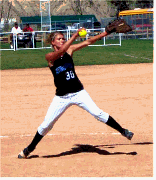
(12) CLOSED-OPEN-CLOSED
– This is the most
difficult part of learning to pitch. When you are standing on the
pitching rubber facing the catcher, you are in a “closed”
position
(imagine yourself as a door as seen by the catcher…you are
“closed”). But then, as you take
the long step forward, approximately halfway through your arm
rotation ou will be in an “open” position…totally sideways to
the catcher. Then as
the arm comes down in the final swing toward the release, the upper
body, then the hips will start to “close”. However, as you will read
below, the hips should only be approximately halfway closed at the
precise release point of the ball. Then, after the
release, the hips will continue to close, allowing the pitcher to
finish in the “ready” position…facing the
batter.
(13) THE STRIDE – The step that you take with your
glove-side foot is often referred to as the “stride”. Although there is much
disagreement among pitching instructors on this issue, we have found
that in most cases, those pitchers who have a longer (and
faster) stride throw a better
fastball.
(NOTE FOR BEGINNING PITCHERS: Wait a while before your
start practicing with a longer stride. Practice the basic
mechanics of pitching first…you can start lengthening the size of
your step several weeks or months from
now.)
How long should the stride be? Although this is
something that must be right for the pitcher, a typical stride for a
leaping-style pitcher is 90% to 120% of her height. We encourage our
pitchers to stride five inches or more beyond their height. Therefore, a 5’6”
pitcher will often stride 6 feet or more.
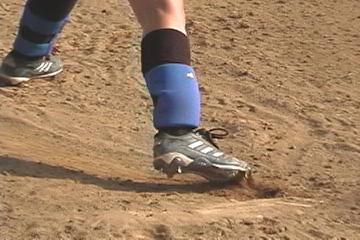
(14) NO “LEAPING”
– All pitchers will
either take a long step or “leap” out to get better distance. However, all organizations
sponsoring girls softball do not allow a pitcher to become airborne
during the pitch…it is illegal to have both feet in the air at the
same time. That
is why pitchers who use a “leaping” style must also “drag” the toe
of the push-off foot on the ground until the stride foot touches
down. Typically, this
toe drag will be on inside of the toe of the shoe, and will make an
arc pattern in the dirt starting at the pitching rubber and
continuing toward the glove side for a foot or
more.
(15) ARM ROTATION
– As the arm comes
forward, keep it relaxed and straight…but not stiff. The arm speed should be
consistent and fast the whole way around (Eventually,
you will learn to add an “arm whip”… accelerating the arm during the
final portion of the armswing just before the release. But do NOT practice the arm
whip yet). As the arm is making the
circle, your body will usually go to an open (sideways) position and
then will start closing as you approach the release of the pitch.
(16) NO BOBBLE HEAD
- During this entire
arm circle and closed-open-closed sequence, do NOT let your head
move sideways. As much
as you can, keep your head straight…not stiff…just straight. We often find that if
a right-handed pitcher’s head tilts left, the pitch goes to the
right.
THE RELEASE – There are several important
things that need to happen as the arm swings down toward the release
point…and they need to happen at the same
time:
- (18) Keep the wrist back as your arm approaches the release
point so it can automaticalloy whip forward at the precise instant
you release the ball.
-
(19) Keep your arm outstretched,
but not stiff,
as you release the
ball. Do not allow your elbow to bend more than 15 or 20
degrees.
-
(20) “Snapping” – Although you might have been told to
“snap the ball”, do NOT try to snap your wrist forward at this
point. It can cause
timing problems, and often cause you to pitch high.
Instead, seen #18 above, and "whip" your arm down through the final
part of the arm rotation and through the release of the
pitch. Your hand is at the end of your whipping arm, so
it will whip forward at the precise release of the
ball...conseqently giving you a better snap than if you try to do
it...and it happens automatically.
-
(21) Fingers behind the
ball – You can get
better speed and control if your fingers are behind the ball as it
leaves your hand.
We often tell pitchers to think of it as “pointing the inside
of your wrist toward the catcher.” Some pitchers are
taught to “roll the ball over” as it is being released in order to
get a slight curve or drop on the fastball…but we recommend against
that. The
“over-the-top” release is often used by men pitchers. We do NOT recommend it for
our students, and feel it could be injurious to young or smaller
pitchers. 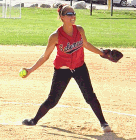
-
(22)
Stay tall at the release. Bring your shoulders back as
your pitching arm starts its final downswing toward the release
point, so you can be upright and tall at the finish. Do NOT bend at the
waist. Bending
slows down pitching speed, and often causes pitches to go
high.
-
(23) Keep your shoulders
level as you
release the pitch…no dipping down on the throwing-arm
side.
(24) THE FOLLOW-THROUGH
– This is another of
those areas where pitching instructors often have differing
opinions. Our
recommendation is to let the arm go where it wants to
naturally. At the
instant the ball has left your hand, allow your arm to relax, bend,
and follow through straight ahead. For most pitchers who use
the fingers-behind-the-ball and
inside-of-the-wrist-toward-the-catcher method, the arm will bend
slightly, then follow though straight ahead (not across the body)
with the pitching hand finishing up somewhere waist-high or above,
and moving toward the bicep or shoulder.
SO, THERE YOU HAVE
IT. That’s a list
of more than 20 things that you need to train your mind and
body to do in a period of less than 2 seconds. Again, don’t try to do
everything at once!
Many pitchers with years of experience are still trying to
learn…or at least correct…some of the things that are mentioned
above. Learn one
or two of these items… practice them, and make them part of your
habit. THEN, go on to
learn, practice, and develop a couple
more.
GOOD
MECHANICS means good pitching. Make it work for
you.
This article above can be downloaded and printed from
Microsoft Word

Do you want to reprint this article or use it on your website
or in your newsletter?
As long as it is not for
profit, our only requirement is that you first notify us, then
include the following sentence:
Article by Gerald Warner of
PitchSoftball.com
and include a reference to this
website: www.pitchsoftball.com
If
you have questions or need more information
E-mail us, or call Pitching Instructor Gerald Warner in
Colorado at (720) 200-4575
| 



